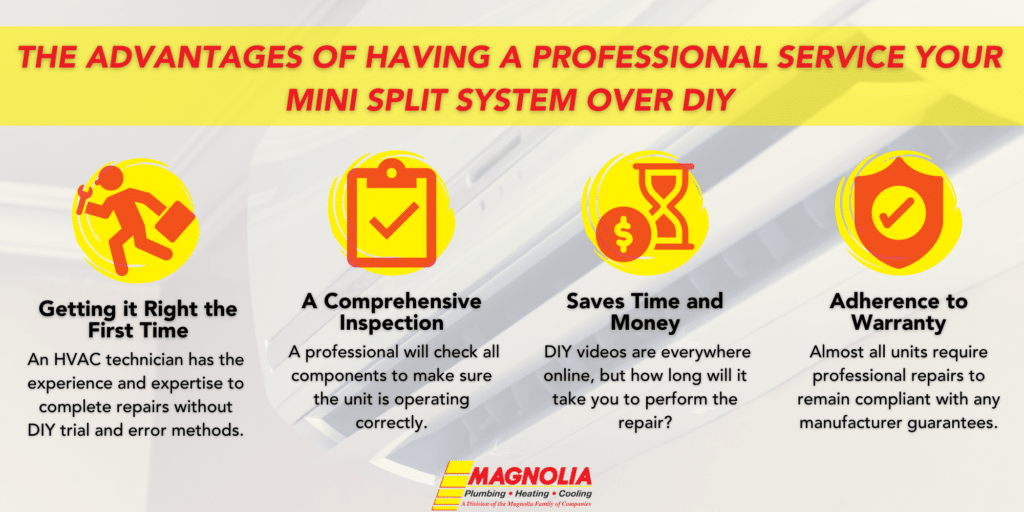Do I Need to Fill My Ductless System with Refrigerant This Summer?
Published: July 14, 2020 / Last Updated: April 30, 2025
Refrigerant is a vital component of practically every air conditioning system in use today. Despite that, it isn’t well-understood by the majority of homeowners across the country. As a result, we often get questions like the one above about how refrigerant should be handled in an air conditioning system. Let’s examine the role of refrigerant in your air conditioning system and when you need to add more to it.
Refrigerant
So, what is refrigerant, anyway? Refrigerant is not one substance but a catchall term for a variety of different heat transfer fluids that all serve the same purpose. In your ductless system air conditioner, refrigerant is the fluid that is used to transfer heat between the home and the outside environment. The system evaporates refrigerant in either the inside unit or the outside unit to absorb heat from the surrounding air. Then, it sends the refrigerant gas down the refrigerant line to the other unit, where it is condensed back into liquid. This releases the stored heat. The liquid refrigerant is then sent back to the original unit, and the cycle begins again. The system never consumes refrigerant but recycles it back and forth during operation.
When to Refill
Normally, you shouldn’t ever need to refill the refrigerant levels in your ductless system. The initial charge of refrigerant your system receives upon installation should be enough to last for its entire lifespan. The only time when this is not the case is when a leak develops in the refrigerant line. This will drain the system of refrigerant and will eventually cause a breakdown if the leak is not patched. Here are five signs that your mini-split has a refrigerant leak:
1. Your Vent is Blowing Hot or Lukewarm Air
If you’re expecting cold air to blow from your vents and find that the air is warmer than it should be, it’s a good sign that your mini-split might have a refrigerant leak. Without proper refrigerant levels, the unit won’t be able to absorb and remove heat from your home. It will invite warm outdoor air indoors, instead.
2. You’re Adjusting Your Thermostat too Often
A mini-split with a refrigerant leak can take much longer to cool your indoor space. That means you’re adjusting the thermostat more often in an attempt to reduce the temperature in your home or place of business.
3. There’s Frost on Your Evaporator Coils
Frosty coils are a byproduct of high condensation due to low levels of refrigerant. If you don’t address this issue quickly and add refrigerant or assess your unit for leaks, it may lead to a broken down compressor, which requires an expensive repair.
4. Your AC Unit is Hissing
If the refrigerant is leaking, there’s a good chance that your unit may make a hissing sound. This is a good indication to call a professional for help with repairing and charging your mini-split system.
5. Your Electric Bills Have Increased
A leak means your AC unit needs to work harder to cool your house, especially if you’re consistently turning down the thermostat.
What To Do if You Have a Refrigerant Leak
If your refrigerant is low, you may think it’s best to look up how to add refrigerant to a mini-split heat pump and take care of the problem yourself. However, a leak requires a more direct and thorough approach than just topping the fluids. Additionally, it’s important to entrust the work to a professional like a Magnolia air conditioning technician who knows how to charge a mini-split.

How Often Does a Heat Pump Need Refrigerant?
The refrigerant in your HVAC system should last as long as the unit itself, or about 15 years. However, if your unit has a leak, an HVAC professional may need to add refrigerant to your mini-split after repairs have been completed.
Magnolia Plumbing, Heating & Cooling installs and services ductless systems throughout Baltimore, MD. If you need a ductless system installed, repaired, maintained, or replaced, contact us today to speak with one of our ductless experts.
Share This Article:
Request An Estimate
Contact us for a free estimate. It's just one form or phone call away!
Join Our Newsletter
Submit your email to receive promotions.
